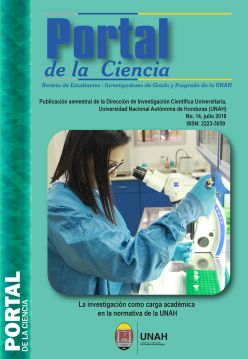Molecular and serological characterization of Escherichia coli from Hydric origin of two geographical zones of Honduras
DOI:
https://doi.org/10.5377/pc.v0i14.6638Keywords:
Water quality, phylogeny, pathotypesAbstract
A study published in 2016 by the school of Biology on the spatial and temporal variation of the diversity and abundance of the phytoplankton of Lake Yojoa in the hydrological year 2014-2015 had an alternate part where the microbiological quality of the water samples was obtained from it. Water analysis confirmed the presence of fecal coliforms with growth at 44°C. The main objective was to classify molecularly the pathotypes and phylogenetic groups of E. coli from strains obtained from samples of water sources. Additionally, the classification of strains in serotypes was achieved, which provided more information and epidemiological coincidences with other studies from other sources. The study comprised the year 2016 where the whole experimental part was carried out and 2017, the analysis of all the data obtained was concluded. A total of 32 strains were analyzed. 47% (n = 15) were strains obtained from a water study in Francisco Morazán (they joined the study due to its water source). 53% (n = 17) corresponds to the strains obtained from Lake Yojoa. The phylogeny of these strains is varied since they were able to locate in 7 of 8 phylogenetic groups of which can be discriminated by the technique used. Of the total of strains analyzed, 75% (n = 24) amplified for different virulence factors. 50% (n = 16) represents the original strains of Lake Yojoa and 25% (n = 8) the strains of Francisco Morazán. 63% (n = 15) corresponds to the EPEC pathotype, which is divided as follows: 17% (n = 4) corresponds to atypical EPEC and 46% (n = 11) to typical EPEC. There are common serotypes in both water sources as well as toxin-producing strains. The existence of an enteroaggregative pathotype of E. coli that for the first time is registered in Honduras and has the capacity to create biofilms on aquatic surfaces. The existence of strains that harbor virulence factors in aquatic environments is a fact that can be a potential public health problem in vulnerable populations exposed to these water sources. More must be inquired about the fact that these strains are or are not potential pathogens for the human or beneficial for the environment and ecological niche in which they are found.
Downloads
1100
Downloads
Published
How to Cite
Issue
Section
License
© Revista Portal de la Ciencia
Los autores/as que publiquen en esta revista aceptan las siguientes condiciones:
De acuerdo con la legislación de derechos de autor, Revista Portal de la Ciencia, reconoce y respeta el derecho moral de los autores, así como la titularidad del derecho patrimonial, el cual será cedido a la revista para su difusión en acceso abierto en versión impresa y en formato digital. Al formar parte de múltiples indexadores, bases de datos y sistemas de referencia, los artículos que sean publicados por Revista Portal de la Ciencia se encontrarán visibles y serán descargados también de estos sitios web, indicando, en todos los casos, la autoría de los artículos, la fecha de publicación y el número de la revista al que corresponden.

Este obra está bajo una licencia de Creative Commons Reconocimiento-NoComercial 4.0 Internacional.
Usted está en libertad de:
- Compartir: copiar y redistribuir el material en cualquier medio o formato
- Adaptar: remezclar, transformar y crear a partir del material
Bajo las siguientes condiciones:
- Reconocimiento: Usted debe darle crédito a esta obra de manera adecuada, proporcionando un enlace a la licencia, e indicando si se han realizado cambios. Puede hacerlo en cualquier forma razonable, pero no de forma tal que sugiera que usted o su uso tienen el apoyo del licenciante.
- Uso no comercial: Usted no puede hacer uso del material con fines comerciales.




